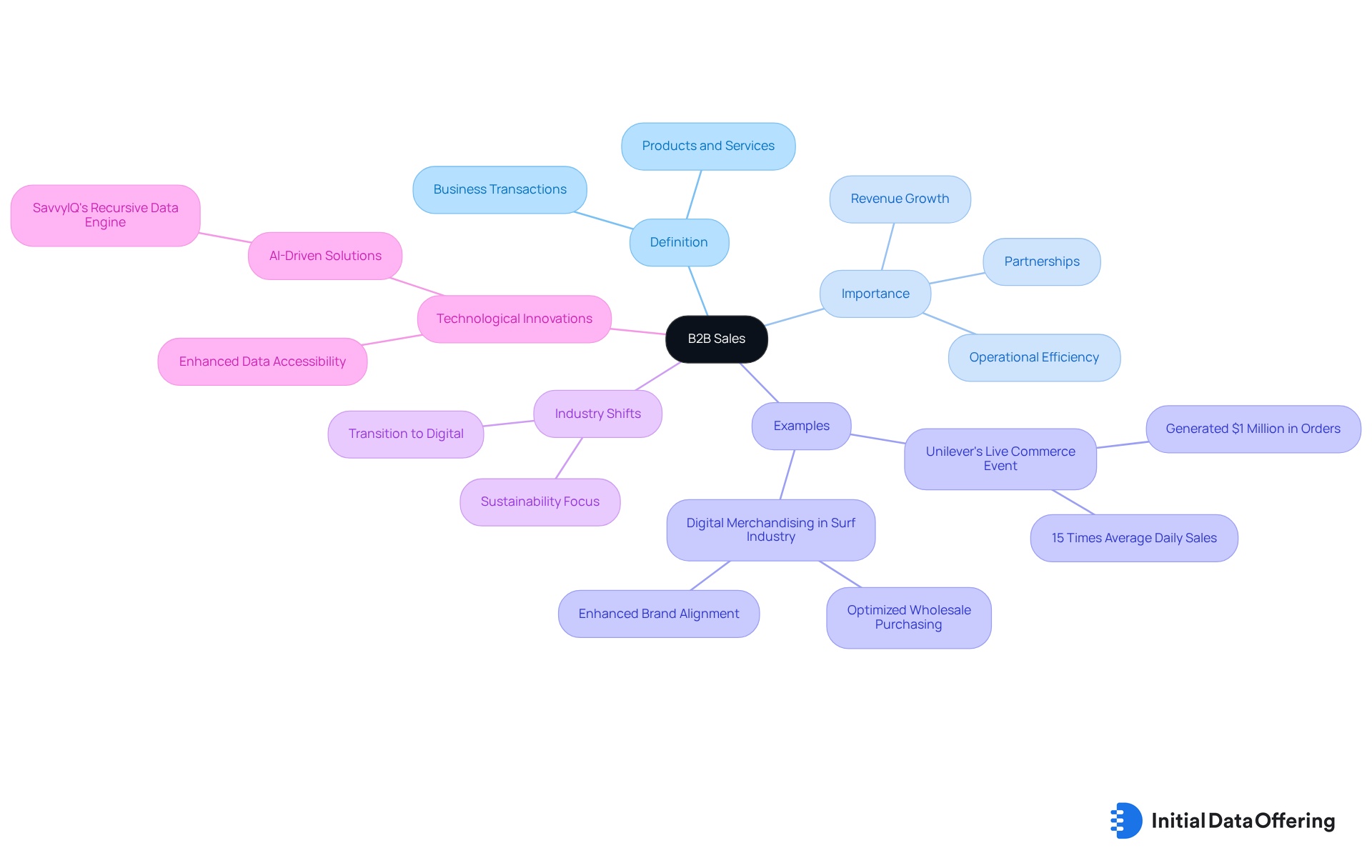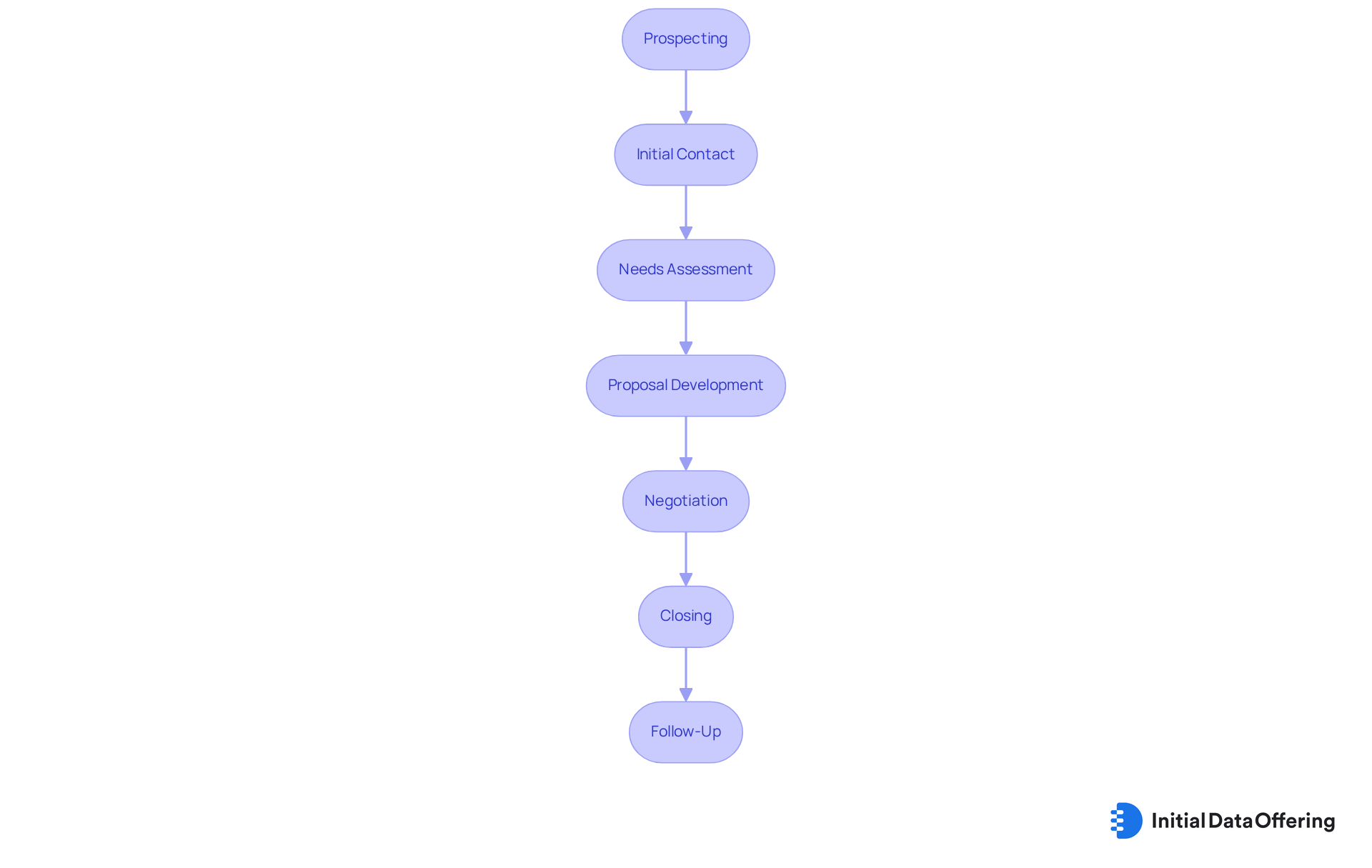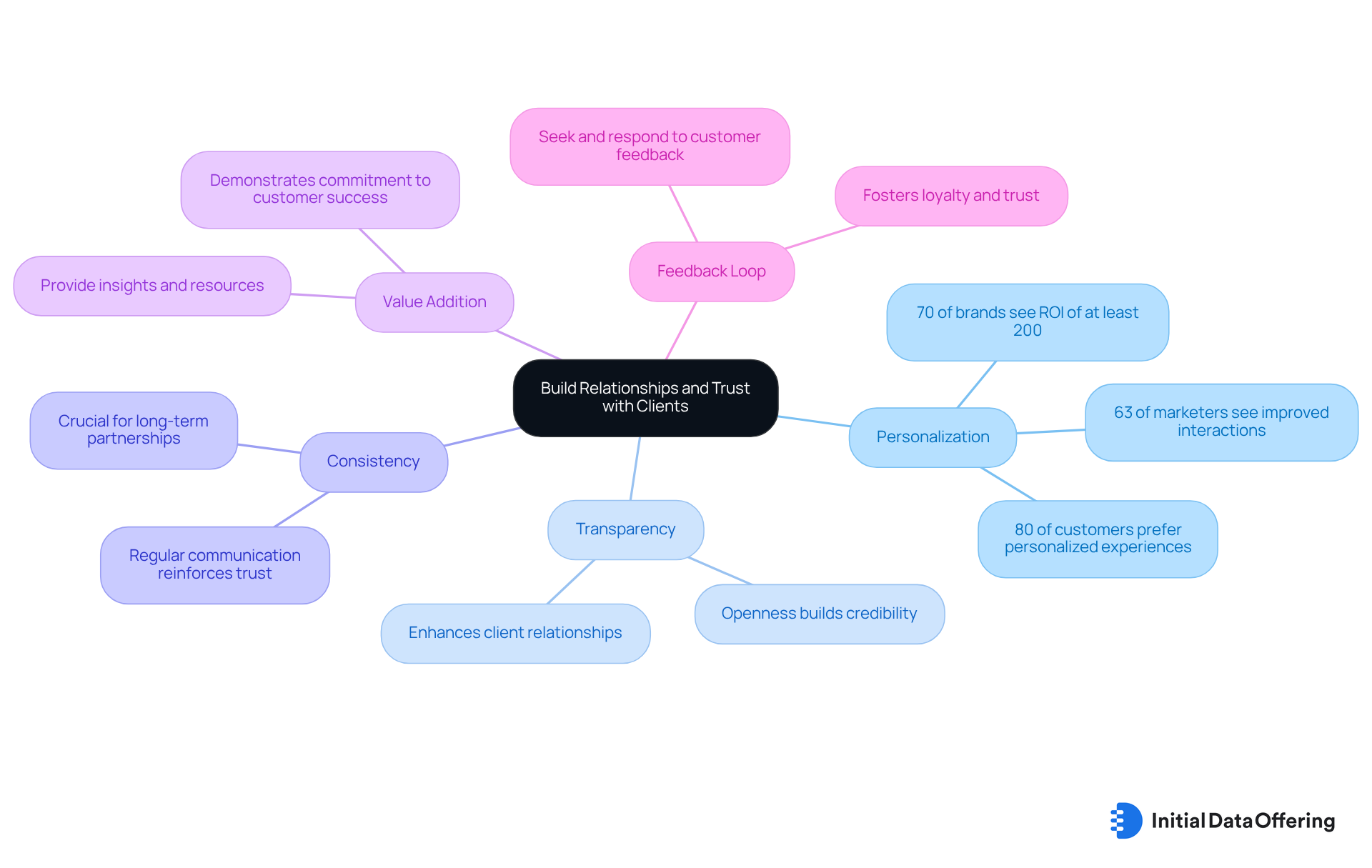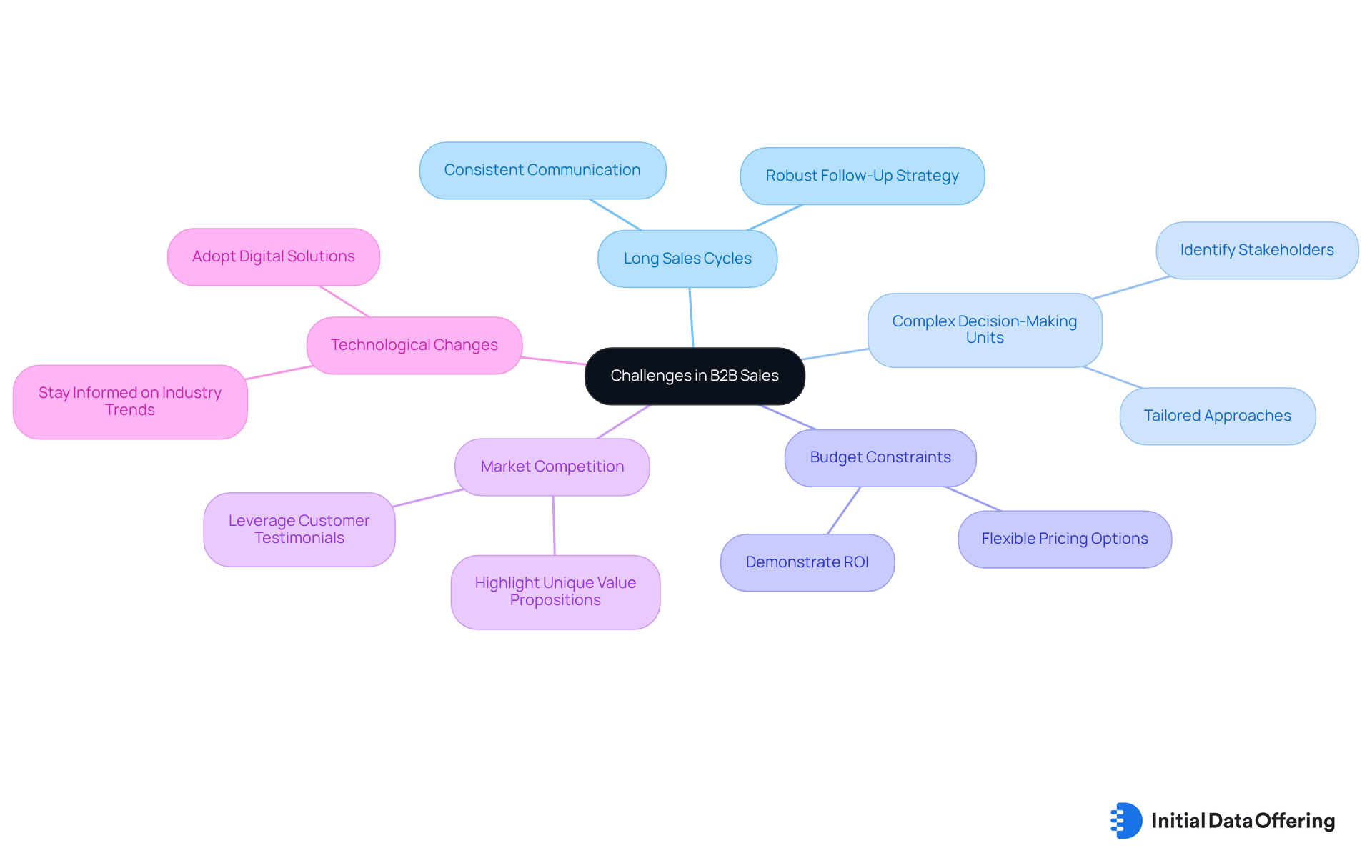Mastering Business to Business Sales: Key Steps for Success

Mastering Business to Business Sales: Key Steps for Success
Overview
Mastering business-to-business (B2B) sales requires a comprehensive understanding of the sales process, the ability to build enduring relationships, and strategies to overcome challenges for achieving success. Key steps in this process include:
- Prospecting
- Conducting a needs assessment
- Diligent follow-up
Each step plays a crucial role in the overall effectiveness of B2B sales efforts. Personalization, transparency, and strategic approaches are vital in navigating long sales cycles and budget constraints. By focusing on these elements, businesses can foster strong client relationships, which ultimately drives revenue growth.
Introduction
In the intricate world of business transactions, the significance of business-to-business (B2B) sales is paramount. Characterized by larger transactions and longer sales cycles, these sales foster partnerships that drive innovation and revenue growth across industries. As companies strive to master B2B sales strategies, they encounter the challenge of navigating complex decision-making processes and evolving market dynamics.
What essential steps can businesses take to enhance their sales processes and build lasting relationships that lead to sustained success? This inquiry not only underscores the relevance of B2B sales but also invites companies to reflect on their strategies for improvement.
Define B2B Sales and Its Importance
Business to business sales refer to transactions where one company provides products or services to another. This model is vital across various sectors, characterized by larger transactions and extended sales processes compared to business to business sales and B2C (business-to-consumer) transactions. The significance of business to business sales lies in their capacity to forge partnerships that drive innovation, enhance operational efficiency, and boost revenue growth. For example, Unilever's recent live commerce event generated $1 million in orders—15 times its average daily sales—illustrating how effective B2B strategies can yield substantial financial results.
Furthermore, the shift to digital merchandising in the surf industry has optimized wholesale purchasing processes, enabling brands to better align with retailer preferences. This transition not only conserves time and resources but also promotes collaboration, ultimately elevating brand value and improving customer experiences. As companies navigate the complexities of 2025, the role of business to business sales in fostering innovation and revenue growth cannot be overstated.
In this landscape, leveraging AI-driven solutions, such as those offered by SavvyIQ, can markedly enhance business to business sales marketing strategies. SavvyIQ's proprietary AI-powered Recursive Data Engine continuously expands and enriches a dynamic graph of 265 million global entities, equipping businesses with essential insights into market dynamics and customer behavior. This capability empowers companies to make informed decisions, automate workflows, and eliminate manual data tasks, thereby refining their sales processes. Expert insights underscore that successful business to business sales partnerships are fundamental for achieving operational excellence and sustaining a competitive advantage in the marketplace. Zig Ziglar wisely noted that helping others is crucial to personal success, underscoring the collaborative nature of B2B transactions.
In conclusion, understanding the dynamics of business to business sales is essential for companies seeking to establish a competitive edge and drive significant growth in their markets.

Outline the B2B Sales Process Steps
The B2B sales process typically consists of several key steps that are essential for success:
-
Prospecting: Identify potential customers through market research and networking. Effective prospecting techniques are crucial; in fact, 75% of B2B buyers prefer a rep-free purchasing experience. This statistic highlights the necessity for innovative outreach methods that leverage digital channels and self-service options.
-
Initial Contact: Reach out to prospects via email, phone calls, or social media. Personalized cold emails yield a 32% higher response rate compared to generic ones, while emails with personalized subject lines are 50% more likely to be opened. This underscores the importance of tailored communication in capturing attention effectively.
-
Needs Assessment: Engage in discussions to understand the specific requirements and challenges of the customer. Sales professionals should prioritize listening, as 63% of sellers believe that grasping customer needs is central to effective sales performance. As Dale Carnegie noted, building trust through consistent actions is vital at this stage.
-
Proposal Development: Create customized proposals that align with the customer's needs. A solid proposal should reflect insights gained during the needs assessment, ensuring it meets the client's expectations and demonstrates a clear understanding of their requirements.
-
Negotiation: Discuss terms, pricing, and conditions to reach a mutually beneficial agreement. This stage often requires several follow-ups; 80% of transactions necessitate a minimum of five attempts to finalize a deal, with 93% of converted leads responding on the sixth attempt. This emphasizes the significance of persistence in negotiations.
-
Closing: Finalize the deal and ensure all contractual obligations are fulfilled. The typical transaction win rate stands at 21%, suggesting that persistence and effective communication are essential for successful closures. It's crucial to recognize that the average B2B sales cycle can last up to 8 months, which helps in managing expectations during this phase.
-
Follow-Up: Maintain communication post-sale to ensure customer satisfaction and explore future opportunities. Regular follow-ups can significantly enhance customer retention, demonstrating that the customer's business is valued and appreciated.
By comprehending and applying these steps, sales experts can navigate the complexities of business to business sales transactions more efficiently. This ultimately leads to improved results and stronger relationships with customers.

Build Relationships and Trust with Clients
To cultivate robust relationships and establish trust with clients in B2B sales, implement the following strategies:
-
Personalization: Customize your communication and solutions to align with the unique needs of each client. Personalization is not merely a trend; it greatly improves interactions with clients. For instance, 63% of marketers observe its beneficial effect on conversion rates. Additionally, 70% of brands that use advanced personalization see a return on investment of at least 200%. This indicates that 80% of customers are more likely to engage with companies that offer personalized experiences, showcasing the significant benefits of this strategy.
-
Transparency: Foster openness regarding your processes, pricing, and any potential challenges. Transparency builds credibility, which is essential in business to business sales relationships where trust is paramount. How can your openness enhance your client relationships?
-
Consistency: Ensure regular communication and uphold commitments to enhance reliability. Consistent engagement reinforces trust and keeps customers informed, which is crucial for long-term partnerships. Consider how maintaining consistency can positively impact your client retention rates.
-
Value Addition: Go beyond the sale by providing insights, resources, or support that demonstrate your commitment to the success of the customer. This approach not only strengthens relationships but also positions you as a valuable partner in their growth. What additional value can you offer to your clients?
-
Feedback Loop: Actively seek and respond to customer feedback to refine your offerings and deepen the relationship. A feedback-driven approach shows clients that their opinions matter, fostering loyalty and trust. In fact, 63% of marketers have observed that personalization improves client interactions.
Applying these strategies can greatly improve business to business sales relationship dynamics, leading to higher client retention and satisfaction. For example, the FloMAX eCommerce Transformation case study illustrates how effective personalization strategies improved customer experience and operational efficiency.

Overcome Challenges in B2B Sales
Challenges in business to business sales can require strategic approaches to navigate effectively.
-
Long Sales Cycles: A robust follow-up strategy is essential to keep prospects engaged throughout the decision-making process. Research indicates that the average B2B transaction cycle length in 2025 is projected to extend significantly, with estimates suggesting it could reach up to 18 months. This necessitates consistent communication to maintain interest and facilitate decision-making.
-
Complex Decision-Making Units: It is crucial to identify all stakeholders involved in the purchasing process and tailor your approach to address their unique concerns. Understanding the dynamics within these units can facilitate smoother negotiations and foster collaboration, ultimately leading to more successful outcomes.
-
Budget Constraints: Be prepared to discuss flexible pricing options or demonstrate the ROI of your solution to alleviate budget concerns. Companies that actively manage their budgets and demonstrate sustainable practices can secure an 18% higher return on investment. This highlights the importance of aligning your offerings with financial goals to gain buy-in from decision-makers.
-
Market Competition: Differentiate your offerings by highlighting unique value propositions and leveraging customer testimonials. In a competitive landscape, showcasing how your solution meets specific needs can enhance your appeal and establish a stronger market presence.
-
Technological Changes: Staying informed about industry trends and adjusting your strategies to include new technologies is vital for improving the selling process. As Josh Reddin noted, The North Face's transition to digital merchandising illustrates how embracing technology can lead to significant cost savings and improved efficiency. This shift not only reduced their B2B marketing budget by 35% but also improved product speed to market by 17%, demonstrating the strategic value of digital solutions.
By addressing these challenges with strategic approaches, businesses can navigate the complexities of business to business sales more effectively. This ultimately drives better outcomes and fosters long-term relationships.

Conclusion
Mastering the art of business-to-business (B2B) sales is crucial for companies aiming to thrive in competitive markets. Understanding the intricacies of B2B transactions allows businesses to forge valuable partnerships that enhance operational efficiency and drive significant revenue growth. Effective B2B sales strategies are paramount for achieving a sustainable competitive advantage in today's dynamic landscape, as highlighted throughout this article.
Key steps in the B2B sales process—such as prospecting, needs assessment, and relationship building—are critical for success. Personalization, transparency, and consistent communication emerge as vital strategies for cultivating trust and fostering long-term client relationships. Addressing common challenges, such as lengthy sales cycles and budget constraints, requires a strategic approach that leverages technology and innovative solutions to navigate these complexities effectively.
Ultimately, the significance of mastering B2B sales cannot be overstated. As businesses continue to evolve, embracing these strategies and insights will enhance sales performance and pave the way for enduring partnerships. Companies are encouraged to reflect on their current practices, adapt to emerging trends, and prioritize relationship-building efforts. How can your organization implement these strategies to secure its place in the future of B2B commerce?
Frequently Asked Questions
What is B2B sales?
B2B sales, or business-to-business sales, refer to transactions where one company provides products or services to another company.
Why are B2B sales important?
B2B sales are important because they help forge partnerships that drive innovation, enhance operational efficiency, and boost revenue growth.
How do B2B sales differ from B2C sales?
B2B sales are characterized by larger transactions and extended sales processes compared to B2C (business-to-consumer) transactions.
Can you provide an example of successful B2B sales?
An example of successful B2B sales is Unilever's live commerce event, which generated $1 million in orders—15 times its average daily sales.
How has the surf industry adapted to B2B sales?
The surf industry has optimized wholesale purchasing processes through digital merchandising, allowing brands to better align with retailer preferences and promote collaboration.
What role does AI play in enhancing B2B sales?
AI-driven solutions, such as those from SavvyIQ, enhance B2B sales marketing strategies by providing insights into market dynamics and customer behavior, automating workflows, and refining sales processes.
What is the significance of successful B2B sales partnerships?
Successful B2B sales partnerships are fundamental for achieving operational excellence and sustaining a competitive advantage in the marketplace.
What is a notable quote regarding the nature of B2B transactions?
Zig Ziglar noted that helping others is crucial to personal success, highlighting the collaborative nature of B2B transactions.
What should companies understand about B2B sales to thrive?
Companies should understand the dynamics of B2B sales to establish a competitive edge and drive significant growth in their markets.